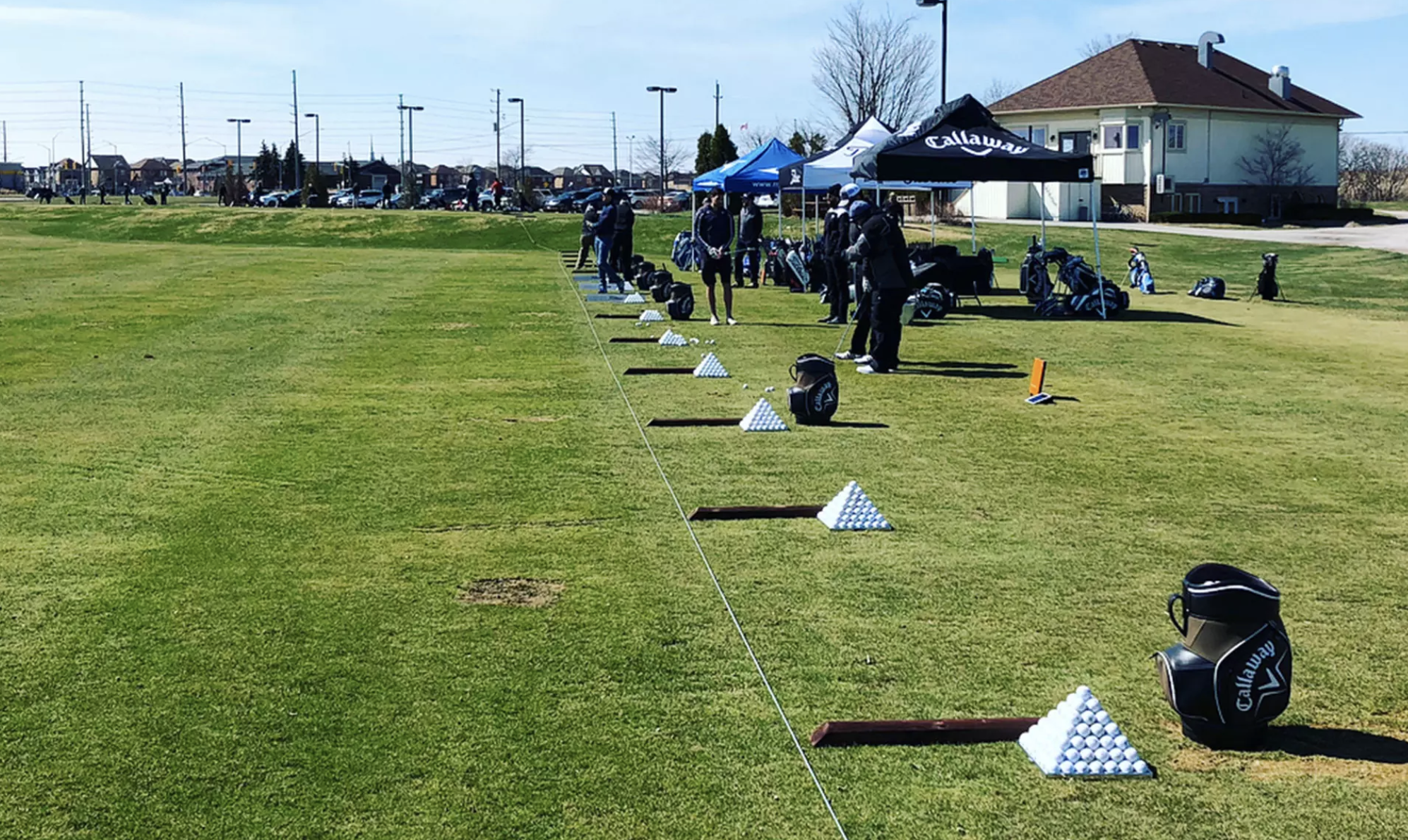Instruction
The Wedge Guy: Fixing what’s broke

Understand that today’s post is coming from a bona fide lifetime range rat. I’ve always loved time on the range, hitting ball after ball after ball, trying to become the best ball-striker and shotmaker I could be. My Dad’s advice as I was growing into the game was always, “there’s nothing wrong with your game another five thousand practice balls won’t fix.”
My childhood idol was Ben Hogan, so I studied his books, “Power Golf” and “Five Lessons: The Modern Fundamentals of Golf,” relentlessly. And I made myself into a pretty good player, with the strength of my game always being hitting fairways and greens. To be honest, the chipping/pitching/putting part of the game just didn’t interest me all that much.
Maybe because my father and my brother were both such good putters and pretty effective around the greens, I felt like my mark had to be through outstanding ball-striking.
But as I got older, I realized that any measurable gains I might make on becoming a better player would be through improving my scoring skills. Even the best players in the game only hit 12-14 greens per round, and I’ve always been right there. But PGA players turn that into 65s and 68s, while I turned mine into 71s and 75s, or worse.
The point of sharing that is to encourage all of you to – as we enter the 2022 season – to honestly and candidly assess where it is your game can use the most improvement. And my bet is – regardless of your handicap – you’ll find that answer is within 50-75 yards from the flag. Whether your goal is to break 90 or par, you’ll likely find that the shots that kept you from that goal are happening much closer to the green than the tee.
- How often do you miss a putt under 6-8 feet for par or bogey?
- How often do you hit a chip or pitch shot that leaves you outside that range . . . or completely misses the green? I’ve always said when you have a wedge in your hand for the second shot in a row, you have completely thrown one or more shots away.
- So, unless you are committed to instruction and the long-term process of changing your swing to change your ball-striking consistency, your time would be better spent honing your short game skills and your putting, and here’s where I think we can divide into two primary groups – those looking to break 80 and those looking to break 90 or 100.
For you higher handicap players, I advise your practice time be invested in two primary areas:
- Learning to hit a basic pitch and chip shot so that you can do it with confidence and consistency. Your goal is to make sure a missed green (of which you have 13-15 per round) leads to nothing worse than a bogey almost all the time. Go to your golf professional and invest the time and money to learn a technique for chipping and pitching that is reliable and repeatable.
- Practice making putts of eight feet or less. If you can get better in this range, it will take pressure off your short game and lower your scores. Again, get a pro to help if you need to, as these putts are usually pretty straight and a sound technique will improve your performance quickly.
For you more advanced players trying to break 80, 75 or even par, your goals are not all that different:
- Learn how to hit a variety of shots around the greens. Even if you tend to always pull the sand or lob wedge, spend some time seeing what your other wedges can do. I find it a lot easier to just change clubs to make the ball fly lower and release a bit more, than I do to try to manipulate my technique to achieve those goals.
- Know when to be bold, when not to. Sometimes a missed green leaves us short-sided or with a high-difficulty recovery. If you aren’t sure you know that shot and can pull it off, play away from the hole and take your medicine with a bogey. Doubles usually come from those greenside shots that are the most risky.
- Like the other golfers, improve your statistics inside eight feet. That means working on your stroke a bit, but more likely working on your routine. Get your line, focus your attention on the putt and relax . . . make a sound stroke.
So, there is my advice for today. If it ain’t broke, don’t fix it — and really analyze what might be broke.
- LIKE69
- LEGIT15
- WOW3
- LOL1
- IDHT1
- FLOP1
- OB1
- SHANK4
Instruction
Clement: Laid-off or perfect fade? Across-the-line or perfect draw?

Some call the image on the left laid off, but if you are hitting a fade, this could be a perfect backswing for it! Same for across the line for a draw! Stop racking your brain with perceived mistakes and simply match backswing to shot shape!
- LIKE0
- LEGIT0
- WOW0
- LOL0
- IDHT0
- FLOP0
- OB0
- SHANK1
Instruction
The Wedge Guy: The easiest-to-learn golf basic

My golf learning began with this simple fact – if you don’t have a fundamentally sound hold on the golf club, it is practically impossible for your body to execute a fundamentally sound golf swing. I’m still a big believer that the golf swing is much easier to execute if you begin with the proper hold on the club.
As you might imagine, I come into contact with hundreds of golfers of all skill levels. And it is very rare to see a good player with a bad hold on the golf club. There are some exceptions, for sure, but they are very few and very far between, and they typically have beat so many balls with their poor grip that they’ve found a way to work around it.
The reality of biophysics is that the body moves only in certain ways – and the particulars of the way you hold the golf club can totally prevent a sound swing motion that allows the club to release properly through the impact zone. The wonderful thing is that anyone can learn how to put a fundamentally sound hold on the golf club, and you can practice it anywhere your hands are not otherwise engaged, like watching TV or just sitting and relaxing.
Whether you prefer an overlap, interlock or full-finger (not baseball!) grip on the club, the same fundamentals apply. Here are the major grip faults I see most often, in the order of the frequency:
Mis-aligned hands
By this I mean that the palms of the two hands are not parallel to each other. Too many golfers have a weak left hand and strong right, or vice versa. The easiest way to learn how to hold the club with your palms aligned properly is to grip a plain wooden ruler or yardstick. It forces the hands to align properly and shows you how that feels. If you grip and re-grip a yardstick several times, then grip a club, you’ll see that the learning curve is almost immediate.
The position of the grip in the upper/left hand
I also observe many golfers who have the butt of the grip too far into the heel pad of the upper hand (the left hand for right-handed players). It’s amazing how much easier it is to release the club through the ball if even 1/4-1/2″ of the butt is beyond the left heel pad. Try this yourself to see what I mean. Swing the club freely with just your left hand and notice the difference in its release from when you hold it at the end of the grip, versus gripping down even a half inch.
To help you really understand how this works, go to the range and hit shots with your five-iron gripped down a full inch to make the club the same length as your seven-iron. You will probably see an amazing shot shape difference, and likely not see as much distance loss as you would expect.
Too much lower (right) hand on the club
It seems like almost all golfers of 8-10 handicap or higher have the club too far into the palm of the lower hand, because that feels “good” if you are trying to control the path of the clubhead to the ball. But the golf swing is not an effort to hit at the ball – it is a swing of the club. The proper hold on the club has the grip underneath the pad at the base of the fingers. This will likely feel “weak” to you — like you cannot control the club like that. EXACTLY. You should not be trying to control the club with your lower/master hand.
Gripping too tightly
Nearly all golfers hold the club too tightly, which tenses up the forearms and prevents a proper release of the club through impact. In order for the club to move back and through properly, you must feel that the club is controlled by the last three fingers of the upper hand, and the middle two fingers of the lower hand. If you engage your thumbs and forefingers in “holding” the club, the result will almost always be a grip that is too tight. Try this for yourself. Hold the club in your upper hand only, and squeeze firmly with just the last three fingers, with the forefinger and thumb off the club entirely. You have good control, but your forearms are not tense. Then begin to squeeze down with your thumb and forefinger and observe the tensing of the entire forearm. This is the way we are made, so the key to preventing tenseness in the arms is to hold the club very lightly with the “pinchers” — the thumbs and forefingers.
So, those are what I believe are the four fundamentals of a good grip. Anyone can learn them in their home or office very quickly. There is no easier way to improve your ball striking consistency and add distance than giving more attention to the way you hold the golf club.
More from the Wedge Guy
- The Wedge Guy: Golf mastery begins with your wedge game
- The Wedge Guy: Why golf is 20 times harder than brain surgery
- The Wedge Guy: Musings on the golf ball rollback
- LIKE86
- LEGIT13
- WOW6
- LOL1
- IDHT0
- FLOP4
- OB1
- SHANK8
Instruction
Clement: Stop ripping off your swing with this drill!

Not the dreaded headcover under the armpit drill! As if your body is defective and can’t function by itself! Have you seen how incredible the human machine is with all the incredible feats of agility all kinds of athletes are accomplishing? You think your body is so defective (the good Lord is laughing his head off at you) that it needs a headcover tucked under the armpit so you can swing like T-Rex?
- LIKE0
- LEGIT2
- WOW2
- LOL0
- IDHT0
- FLOP0
- OB0
- SHANK2
-

 19th Hole2 weeks ago
19th Hole2 weeks agoDave Portnoy places monstrous outright bet for the 2024 Masters
-

 19th Hole3 days ago
19th Hole3 days agoJustin Thomas on the equipment choice of Scottie Scheffler that he thinks is ‘weird’
-

 19th Hole2 weeks ago
19th Hole2 weeks agoTiger Woods arrives at 2024 Masters equipped with a putter that may surprise you
-

 19th Hole3 days ago
19th Hole3 days ago‘Absolutely crazy’ – Major champ lays into Patrick Cantlay over his decision on final hole of RBC Heritage
-

 19th Hole2 weeks ago
19th Hole2 weeks agoTwo star names reportedly blanked Jon Rahm all week at the Masters
-

 19th Hole1 week ago
19th Hole1 week agoReport: LIV Golf identifies latest star name they hope to sign to breakaway tour
-

 19th Hole1 week ago
19th Hole1 week agoNeal Shipley presser ends in awkward fashion after reporter claims Tiger handed him note on 8th fairway
-

 19th Hole1 week ago
19th Hole1 week agoBrandel Chamblee has ‘no doubt’ who started the McIlroy/LIV rumor and why
















geohogan
Apr 22, 2022 at 7:20 pm
Totally agree. During a long spell of the putting yips
hit 15 greens in regulation, with 6 three putts .. shot 78.
When cause and cure was explained to me a few years later, yips corrected in 30 minutes.
“There is no similarity between golf and putting; they are two different games, one played in the air, and the other on the ground.”
— Ben Hogan
Bob Jones
Apr 19, 2022 at 9:51 pm
You’re not going to break 100, or 90 consistently, until you get a better swing. Short game and putting don’t help you if you waste strokes getting the ball up to the green. When the handicap gets to 12-13 is when the greens game needs to be emphasized.
LOWEBOY
Apr 19, 2022 at 2:46 pm
For me, I need to be able to execute the shot I have just made perfect practice swings on. Literally perfect practice swings, then chunk, blade, etc. Frustrating. And practicing wedges on the range, a no-go. So inconsistent it’s annoying and not productive. I may get four to ten shots from a bucket of balls that are hit the way I intended them to be hit, and not one after the other, so I have no idea what I did correctly or incorrectly to get the desired results. I get bored on the range, and prefer playing instead, and I know I need the practice, I just wish I could pull off back to back to back to back shots with a wedge so I can gain some consistency.
I am 52, so maybe when I grow up I will be able to have decent wedge game. It’s only those shots that take me out, too. I can drive well, hit good irons, have always been a good putter and can read the greens well, just lack the wedge game.
I saw a video recently, adopted that technique, and am making better contact and have better form, but now I hit the shot further than I did before. More learning ahead.
One thing I have also learned recently, is spine angle makes a huge difference in my game. If I have the roundness, my shots are all over the place. Spine angle in a good place along with the shoulders, I can strike the ball much better, and that includes the wedge shots.
Jay_Jay
Apr 23, 2022 at 3:41 pm
@Loweboy,get a shag bag, fill it with the balls you game on the course, and find a quiet park (or your club, if you’re a member of one) to just hit a bunch of different wedges/short irons.
Tinker with: swing length, choking-down on the grip, how much to open or close the face at address, and see what those different changes do to your flight and roll.
Range balls just don’t feel or behave the same when hit, in my experience.
Plus, it’s cheaper than burning 10+ bucks at the range trying to do the same thing.
Richard Dean Johnson
Apr 18, 2022 at 5:03 am
My alignment stick is basically 4 feet long. Lay it down on the putting green to indicate 4 feet from the cup. Stick a tee in the ground at 4 feet. Lay the stick down again to indicate 8 feet. Stick a tee in the ground to indicate 8 feet. You can leave the alignment stick laying between the 4 and 8 foot tees if you like, but now your 3 ball putting effort can easily identify 4, 6, 8 feet. Do four sets of 3 ball putting at each distance. Eventually lay the stick down again to indicate 12, then 16, then 20 feet, etc..I usually feel by 16 feet if I can’t center the ball on the face of the putter two putts can become very testy.
Speedy
Apr 14, 2022 at 3:13 pm
The Golfing Machine by Homer Kelley is all one needs.
“Sustain the lag.” – Ben Doyle